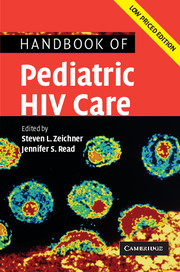Book contents
- Frontmatter
- Contents
- List of contributors
- List of abbreviations
- Foreword
- Preface
- Part I Scientific basis of pediatric HIV care
- Part II General issues in the care of pediatric HIV patients
- Part III Antiretroviral therapy
- 11 Antiretroviral therapy
- 12 Antiretroviral drug interactions
- 13 Metabolic complications of antiretroviral therapy in children
- 14 HIV drug resistance
- 15 Initiating and changing antiretroviral therapy
- 16 Therapeutic drug monitoring
- 17 HIV postexposure prophylaxis for pediatric patients
- Part IV Clinical manifestations of HIV infection in children
- Part V Infectious problems in pediatric HIV disease
- Part VI Medical, social, and legal issues
- Appendix 1 Formulary of antiretroviral agents
- Appendix 2 National Institutes of Health sponsored clinical trials for pediatric HIV disease
- Appendix 3 Selected HIV-related internet resources
- Appendix 4 Selected legal resources for HIV-infected children
- Index
- References
12 - Antiretroviral drug interactions
Published online by Cambridge University Press: 23 December 2009
- Frontmatter
- Contents
- List of contributors
- List of abbreviations
- Foreword
- Preface
- Part I Scientific basis of pediatric HIV care
- Part II General issues in the care of pediatric HIV patients
- Part III Antiretroviral therapy
- 11 Antiretroviral therapy
- 12 Antiretroviral drug interactions
- 13 Metabolic complications of antiretroviral therapy in children
- 14 HIV drug resistance
- 15 Initiating and changing antiretroviral therapy
- 16 Therapeutic drug monitoring
- 17 HIV postexposure prophylaxis for pediatric patients
- Part IV Clinical manifestations of HIV infection in children
- Part V Infectious problems in pediatric HIV disease
- Part VI Medical, social, and legal issues
- Appendix 1 Formulary of antiretroviral agents
- Appendix 2 National Institutes of Health sponsored clinical trials for pediatric HIV disease
- Appendix 3 Selected HIV-related internet resources
- Appendix 4 Selected legal resources for HIV-infected children
- Index
- References
Summary
Treatment of HIV-infected patients requires polypharmacy, during which drug interactions can occur. Pharmacokinetic interactions are those that affect the absorption, distribution, metabolism, or excretion of a drug. Pharmacodynamic interactions produce antagonistic, additive, or synergistic effects. Interactions can be adverse or beneficial. This chapter provides a framework for understanding HIV-related drug interactions through the principles of pharmacology.
Pharmacokinetic drug interactions
Absorption
Fasting, gastric pH, and enteric P-glycoprotein (PGP) expression all can affect absorption. Table 12.1 delineates drug–food interactions and lists antiretroviral drugs that may be administered without regard to food. Antacids (including the buffer in older formulations of didanosine), H2-receptor antagonists, and proton pump inhibitors increase gastric pH, impairing the bioavailability of drugs that require low pH for optimal absorption (e.g., delavirdine, indinavir, itraconazole, ketoconazole). This interaction usually can be avoided by administrating the gastric pH-raising agent 1 to 2 hours later [1–3]. Didanosine is much better absorbed in an alkaline environment because it is acid labile. The original formulation of didanosine included a buffer (calcium carbonate and magnesium hydroxide in tablets or citrate-phosphate in sachets) or had to be reconstituted in antacid. The buffer in didanosine does not affect dapsone absorption but significantly decreases ciprofloxacin absorption [4, 5]. Didanosine or antacids do not interfere with nevirapine. The new formulation of didanosine (Videx® EC) does not have significant interactions with ciprofloxacin, indinavir, or azole antifungals [6, 7]. Drug absorption also can be affected by transporters in the gut.
- Type
- Chapter
- Information
- Handbook of Pediatric HIV Care , pp. 360 - 381Publisher: Cambridge University PressPrint publication year: 2006



